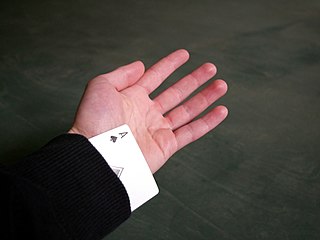Related Research Articles
A pseudorandom number generator (PRNG), also known as a deterministic random bit generator (DRBG), is an algorithm for generating a sequence of numbers whose properties approximate the properties of sequences of random numbers. The PRNG-generated sequence is not truly random, because it is completely determined by an initial value, called the PRNG's seed. Although sequences that are closer to truly random can be generated using hardware random number generators, pseudorandom number generators are important in practice for their speed in number generation and their reproducibility.
The Yarrow algorithm is a family of cryptographic pseudorandom number generators (CPRNG) devised by John Kelsey, Bruce Schneier, and Niels Ferguson and published in 1999. The Yarrow algorithm is explicitly unpatented, royalty-free, and open source; no license is required to use it. An improved design from Ferguson and Schneier, Fortuna, is described in their book, Practical Cryptography
A cryptographically secure pseudorandom number generator (CSPRNG) or cryptographic pseudorandom number generator (CPRNG) is a pseudorandom number generator (PRNG) with properties that make it suitable for use in cryptography. It is also loosely known as a cryptographic random number generator (CRNG).
Articles related to cryptography include:

RSA Security LLC, formerly RSA Security, Inc. and doing business as RSA, is an American computer and network security company with a focus on encryption and encryption standards. RSA was named after the initials of its co-founders, Ron Rivest, Adi Shamir and Leonard Adleman, after whom the RSA public key cryptography algorithm was also named. Among its products is the SecurID authentication token. The BSAFE cryptography libraries were also initially owned by RSA. RSA is known for incorporating backdoors developed by the NSA in its products. It also organizes the annual RSA Conference, an information security conference.
In cryptography, Skipjack is a block cipher—an algorithm for encryption—developed by the U.S. National Security Agency (NSA). Initially classified, it was originally intended for use in the controversial Clipper chip. Subsequently, the algorithm was declassified.

In cryptography, nothing-up-my-sleeve numbers are any numbers which, by their construction, are above suspicion of hidden properties. They are used in creating cryptographic functions such as hashes and ciphers. These algorithms often need randomized constants for mixing or initialization purposes. The cryptographer may wish to pick these values in a way that demonstrates the constants were not selected for a nefarious purpose, for example, to create a backdoor to the algorithm. These fears can be allayed by using numbers created in a way that leaves little room for adjustment. An example would be the use of initial digits from the number π as the constants. Using digits of π millions of places after the decimal point would not be considered trustworthy because the algorithm designer might have selected that starting point because it created a secret weakness the designer could later exploit.
The security of cryptographic systems depends on some secret data that is known to authorized persons but unknown and unpredictable to others. To achieve this unpredictability, some randomization is typically employed. Modern cryptographic protocols often require frequent generation of random quantities. Cryptographic attacks that subvert or exploit weaknesses in this process are known as random number generator attacks.
Fortuna is a cryptographically secure pseudorandom number generator (PRNG) devised by Bruce Schneier and Niels Ferguson and published in 2003. It is named after Fortuna, the Roman goddess of chance. FreeBSD uses Fortuna for /dev/random and /dev/urandom is symbolically linked to it since FreeBSD 11. Apple OSes have switched to Fortuna since 2020 Q1.
Kleptography is the study of stealing information securely and subliminally. The term was introduced by Adam Young and Moti Yung in the Proceedings of Advances in Cryptology—Crypto '96. Kleptography is a subfield of cryptovirology and is a natural extension of the theory of subliminal channels that was pioneered by Gus Simmons while at Sandia National Laboratory. A kleptographic backdoor is synonymously referred to as an asymmetric backdoor. Kleptography encompasses secure and covert communications through cryptosystems and cryptographic protocols. This is reminiscent of, but not the same as steganography that studies covert communications through graphics, video, digital audio data, and so forth.

Random number generation is a process by which, often by means of a random number generator (RNG), a sequence of numbers or symbols that cannot be reasonably predicted better than by random chance is generated. This means that the particular outcome sequence will contain some patterns detectable in hindsight but unpredictable to foresight. True random number generators can be hardware random-number generators (HRNGS) that generate random numbers, wherein each generation is a function of the current value of a physical environment's attribute that is constantly changing in a manner that is practically impossible to model. This would be in contrast to so-called "random number generations" done by pseudorandom number generators (PRNGs) that generate numbers that only look random but are in fact pre-determined—these generations can be reproduced simply by knowing the state of the PRNG.
Below is a timeline of notable events related to cryptography.
The Microsoft Windows platform specific Cryptographic Application Programming Interface is an application programming interface included with Microsoft Windows operating systems that provides services to enable developers to secure Windows-based applications using cryptography. It is a set of dynamically linked libraries that provides an abstraction layer which isolates programmers from the code used to encrypt the data. The Crypto API was first introduced in Windows NT 4.0 and enhanced in subsequent versions.
Cryptovirology refers to the use of cryptography to devise particularly powerful malware, such as ransomware and asymmetric backdoors. Traditionally, cryptography and its applications are defensive in nature, and provide privacy, authentication, and security to users. Cryptovirology employs a twist on cryptography, showing that it can also be used offensively. It can be used to mount extortion based attacks that cause loss of access to information, loss of confidentiality, and information leakage, tasks which cryptography typically prevents.
Dual_EC_DRBG is an algorithm that was presented as a cryptographically secure pseudorandom number generator (CSPRNG) using methods in elliptic curve cryptography. Despite wide public criticism, including the public identification of a backdoor, it was for seven years one of four CSPRNGs standardized in NIST SP 800-90A as originally published circa June 2006, until it was withdrawn in 2014.

In cryptography, Twofish is a symmetric key block cipher with a block size of 128 bits and key sizes up to 256 bits. It was one of the five finalists of the Advanced Encryption Standard contest, but it was not selected for standardization. Twofish is related to the earlier block cipher Blowfish.
OpenPuff Steganography and Watermarking, sometimes abbreviated OpenPuff or Puff, is a free steganography tool for Microsoft Windows created by Cosimo Oliboni and still maintained as independent software. The program is notable for being the first steganography tool that:
NIST SP 800-90A is a publication by the National Institute of Standards and Technology with the title Recommendation for Random Number Generation Using Deterministic Random Bit Generators. The publication contains the specification for three allegedly cryptographically secure pseudorandom number generators for use in cryptography: Hash DRBG, HMAC DRBG, and CTR DRBG.
Dan Shumow is a cryptographer working at Microsoft Research.
Dell BSAFE, formerly known as RSA BSAFE, is a FIPS 140-2 validated cryptography library, available in both C and Java. BSAFE was initially created by RSA Security, which was purchased by EMC and then, in turn, by Dell. When Dell sold the RSA business to Symphony Technology Group in 2020, Dell elected to retain the BSAFE product line. BSAFE was one of the most common encryption toolkits before the RSA patent expired in September 2000. It also contained implementations of the RCx ciphers, with the most common one being RC4. From 2004 to 2013 the default random number generator in the library was a NIST-approved RNG standard, widely known to be insecure from at least 2006, containing a kleptographic backdoor from the American National Security Agency (NSA), as part of its secret Bullrun program. In 2013 Reuters revealed that RSA had received a payment of $10 million to set the compromised algorithm as the default option. The RNG standard was subsequently withdrawn in 2014, and the RNG removed from BSAFE beginning in 2015.